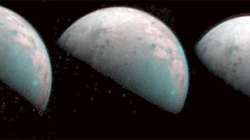First-ever image of Jupiter's Moon Ganymede revealed. Check details
NASA's Juno spacecraft has captured the first infrared images of the north pole of Jupiter's Ganymede, which is the largest moon in the solar system. NASA's Jet Propulsion Laboratory division’s official Twitter profile shared Ganymede's picture and it is gorgeous.

NASA's Juno spacecraft has captured the first infrared images of the north pole of Jupiter's Ganymede, which is the largest moon in the solar system. NASA's Jet Propulsion Laboratory division’s official Twitter profile shared Ganymede's picture and it is gorgeous. Jupiter's moon Ganymede was discovered in 1610. It has a diameter of 5,268 km that is 8 percent larger than the diameter of Mercury and Pluto.
The Jovian Infrared Auroral Mapper (JIRAM) instrument that captured to enthralling picture has three main layers: a sphere of metallic iron at the center, a spherical shell of rock (mantle) surrounding the core, and a spherical shell of mostly ice surrounding the rock shell and the core. The ice shell on the outside is very thick, maybe 800 km (497 miles) thick, as reported by sci-news.com.
- The Jovian Infrared Auroral Mapper (JIRAM) instrument onboard NASA’s Juno spacecraft has captured the first infrared images of the north pole of Ganymede
- Jupiter's moon Ganymede was discovered in 1610. It has a diameter of 5,268 km that is 8 percent larger than the diameter of Mercury and Pluto.
According to experts, as Ganymede has no atmosphere, the surface at its poles is constantly being bombarded by plasma from the magnetosphere of Jupiter. This bombardment has a dramatic effect on the moon’s ice.
“The JIRAM data shows the ice at and surrounding Ganymede’s north pole has been modified by the precipitation of plasma,” said Juno co-investigator Dr. Alessandro Mura, a researcher at the National Institute for Astrophysics, as quoted by sci-news.com.
“It is a phenomenon that we have been able to learn about for the first time with Juno because we are able to see the north pole in its entirety,” she added.
According to the Juno scientists, the water ice near Ganymede’s poles is amorphous.